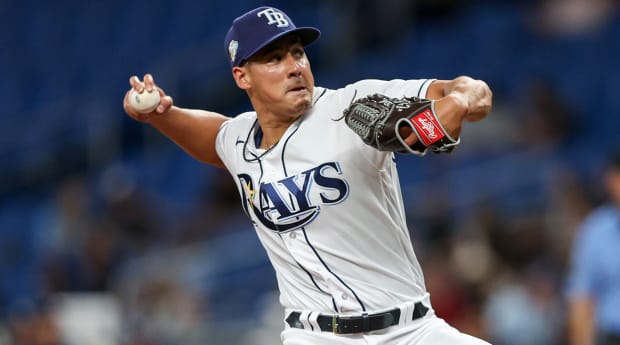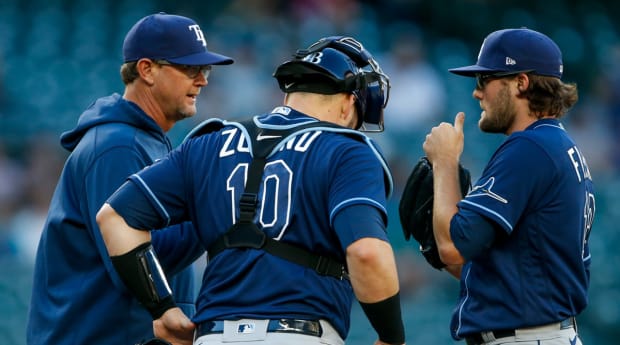There are two places you can find clues to the Rays’ secret sauce of pitching. One is on the modern American version of papyrus, marble or other classic media of wisdom: the cotton T-shirt. The other is a journeyman righthander with a career 4.82 ERA.
The T-shirt is worn by Tampa Bay pitchers and reads “64.2.” You can mull on that for a minute, which is about how long it took for Rays pitching coach Kyle Snyder to turn peripatetic Robert Stephenson into a bullpen weapon.

Nathan Ray Seebeck/USA TODAY Sports
When the Rays called the Pirates on June 2 about Stephenson, Pittsburgh should have hung up. If Tampa Bay calls about one of your pitchers—Tyler Glasnow, Pete Fairbanks, Drew Rasmussen, Jeffrey Springs, etc.—it means you are sitting on an undervalued asset. The Rays are the Antiques Roadshow of pitching. Other teams have no idea what they have in their attic. The Rays do.
Stephenson, 30, was about to be dumped by his third organization in 32 months (traded by Cincinnati and Pittsburgh, waived by Colorado). With the Pirates, Stephenson was 0–3 with a 5.14 ERA. Even though he threw his four-seamer hard (96.9 mph) and with elite spin (2,402 rpm), Stephenson had missed only one bat with his fastball all year. One swing-and-miss on 74 heaters.
The Rays offered Alika Williams, a 24-year-old shortstop blocked by Wander Franco and his 11-year contract. The Pirates said yes. And Snyder went to work.
Like most teams, the Rays love spin. They just know better than most what to do with it. Snyder tightened the break so much on Stephenson’s high-spin slider (an absurd 2,998 rpm) that Statcast now calls it a cutter. Snyder still calls it a slider. By any name, the average against the pitch dropped from .222 with the Pirates to .091 with the Rays.
That’s not all. That fastball that nobody missed? Snyder showed Stephenson how to elevate the pitch, especially with two strikes. The average height of Stephenson’s fastball jumped from 2.55 feet off the ground with Pittsburgh to 2.92 feet with Tampa Bay. The result? Eleven swings and misses on nearly a similar number of fastballs (68).
How much difference does 4½ inches make? That’s about the equivalent of a baseball and a half. Doesn’t sound like much. But for high-spin fastballs like Stephenson’s, it means 81 points on batting average and 96 points on slugging percentage. Those 4½ inches are huge:
| MLB 2023 High-Spin Four-Seamers by Height* | AVG | SLG |
|---|---|---|
2.50–2.59 in. |
.317 |
.548 |
2.90–2.99 in. |
.236 |
.452 |
Spin rate has become a sexy term in pitching. But Snyder prefers an old-school word to describe the magic behind Stephenson’s transformation.
“Movement,” Snyder says, “is what we’re looking for. We’re looking for space creation. The more movement we can create—the more space we can create at velocity—the better off our pitchers are going to be. Like for him, he’s an elite spin rate guy, yes. But it’s kind of 16 inches of carry, which is just slight carry. But he also puts his spin to work.
“The slider has really performed exceptionally well over the last three months. But he’s also gotten a decent number of swings-and-misses [on the fastball] since he’s been here because he’s been able to get the ball above three feet. And if it’s above three feet with two strikes, even better. So, we always kind of just have a line drawn in terms of where it is or where it should [be].”
Snyder has been the Rays’ pitching coach since 2018. His staff has posted a top-three ERA in the league every season, a phenomenal achievement given the Rays’ meager payroll and an injury rate of nearly 50% for all major league pitchers. This year is no different.
The Rays began this week ranked behind only Houston in AL ERA (3.79 to 3.78). Rays pitchers allow the lowest batting average in MLB (.230), the lowest slugging percentage (.382) and the lowest OPS (.678). They have done so despite deploying the fourth-lowest payroll while using 36 pitchers—tied with the Dodgers for the most in baseball—and putting 14 of them on the injured list. Only the Dodgers (16) and Padres and Reds (15) have put more pitchers on the IL.
Like all teams, the Rays make the most of technology and pitching labs, though their Silicon Valley thought culture—“move fast and break things”—usually puts them at the cutting edge of such technology, even with their limited resources. They were the first team, for instance, to use KinaTrax, the markerless motion capture technology, the first to embrace the opener concept and the first to understand the value of catcher pitch framing.
Watch MLB with fuboTV. Start your free trial today.
It is Synder’s way of bridging technology with the humans who actually play the game that is one of Tampa Bay’s greatest assets. Take, for instance, those T-shirts. What in the world is 64.2?
“That’s the record for first-pitch strike percentage,” Snyder says. “We’ve got a ways to go if we’re going to achieve that this year, but it’s just a way to think about it. Yeah, I made a T-shirt. It’s cool. The 2018 Dodgers were at 64.2. We were 63.75 last year.”
This year the Rays are at 61.8%, tied for 12th place, well behind first-place Seattle at 64.1%.
“It's something we shoot for,” Snyder says. “It just kind of resonates, right? The guys wear the T-shirt. They see it. The message is always being delivered without you having to deliver it.”
Major league hitters bat .352 on first-pitch strikes. But Snyder makes sure his pitchers know the odds still favor them by attacking the zone with the first pitch.
“Generally speaking, guys don’t get victimized nearly as much on the first pitch as they think,” he says, “especially if you have multiple pitch types in the heart of the zone.

Joe Nicholson/USA TODAY Sports
“They think something catastrophic is going to always occur. The catchers sometimes do, too. So, you have to show it to them as well. [The odds] really would surprise a lot of guys. It’s only like five [hits] out of every 100 first pitches. Other times out of that a hundred you’re getting the benefit of a swinging strike, an out, a foul ball or a called strike.
“When [catcher] Mike Zunino came into our organization I think in 2019 he talked about the psychology of a hitter. Like, you roll over on the first pitch you get and you’ve got to wait an hour and 15 minutes to see another one.”
Snyder’s math is close enough to make the point. When pitchers dial their first pitch into the strike zone this year, they give up a hit only 6.2% of the time. That means you can control the count 93.8% of the time by attacking the zone.
Even more important to the Rays than first-pitch strikes is the outcome after the first three pitches. What good is a first-pitch strike if the next two pitches are balls? After three pitches the Rays want control of the count (1–2 or 0–2 with foul balls) or the out recorded. They are third in MLB in strike percentage (65.3%) and tied for fourth in fewest pitches per plate appearance (3.83). In simplest form, Rays pitchers attack the zone early and then expand with velocity up or their best breaking ball down.
“There’s a lot of different ways to say, ‘Trust your stuff,’” Snyder says. “Context matters. It’s pretty powerful. I don’t think that’s a secret throughout the industry, but I think it’s just a matter of how you message things for people to understand it.”
After a 29–7 sprint out of the gate, Tampa Bay went 39–39 and lost its hold on the AL East to Baltimore. The Rays held a 4½ game lead on Houston for the first wild card entering this week. But the past week has been a scary one. Shane McClanahan is seeing specialists for a sore elbow, and Glasnow is seeing one about back spasms. With Springs and Rasmussen already out for the season, even Snyder may have trouble working his magic without the team’s top four starting pitchers.
Six years, however, have taught us not to rule out Snyder and the Rays finding a way. Snyder is a former first-round pick who went 8–17 with a 5.57 ERA over five major league seasons with the Royals and Red Sox. He was Stephenson before technology and process took root in pitching development. He comes from a generation that relied on folk wisdom.
“Sure, you did, especially with the Red Sox,” he says. “It was a lot of hearsay. And now it’s measurables. Everything speeds up. There’s still a little trial and error in the process, but the guesswork is no longer there. And it makes it fun.”







